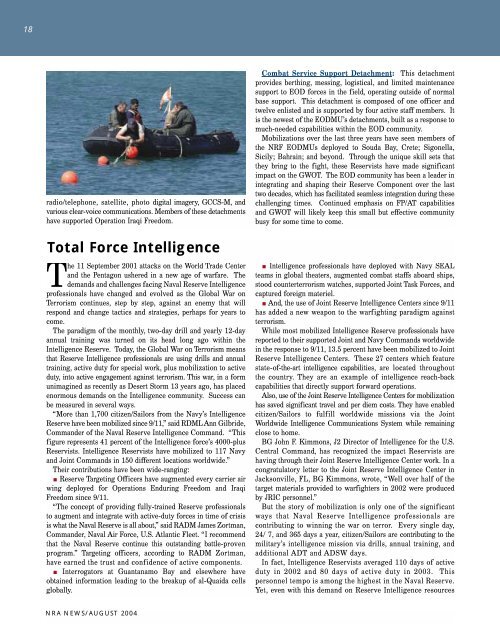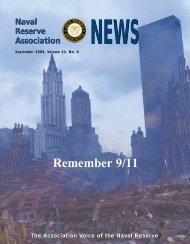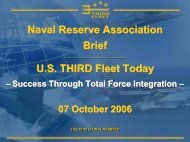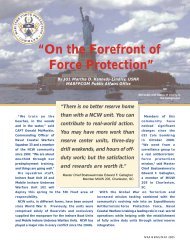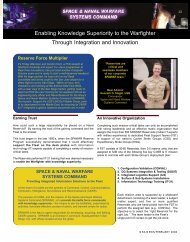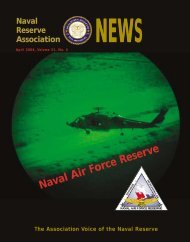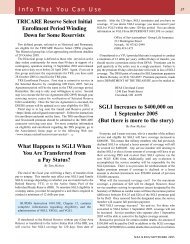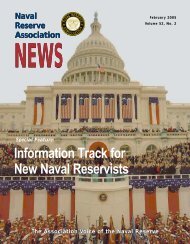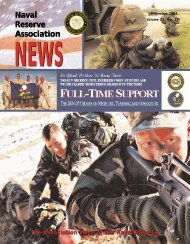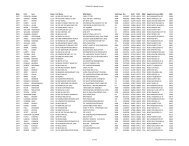Naval Reserve Association Naval Reserve Association
Naval Reserve Association Naval Reserve Association
Naval Reserve Association Naval Reserve Association
You also want an ePaper? Increase the reach of your titles
YUMPU automatically turns print PDFs into web optimized ePapers that Google loves.
18<br />
radio/telephone, satellite, photo digital imagery, GCCS-M, and<br />
various clear-voice communications. Members of these detachments<br />
have supported Operation Iraqi Freedom.<br />
Total Force Intelligence<br />
The 11 September 2001 attacks on the World Trade Center<br />
and the Pentagon ushered in a new age of warfare. The<br />
demands and challenges facing <strong>Naval</strong> <strong>Reserve</strong> Intelligence<br />
professionals have changed and evolved as the Global War on<br />
Terrorism continues, step by step, against an enemy that will<br />
respond and change tactics and strategies, perhaps for years to<br />
come.<br />
The paradigm of the monthly, two-day drill and yearly 12-day<br />
annual training was turned on its head long ago within the<br />
Intelligence <strong>Reserve</strong>. Today, the Global War on Terrorism means<br />
that <strong>Reserve</strong> Intelligence professionals are using drills and annual<br />
training, active duty for special work, plus mobilization to active<br />
duty, into active engagement against terrorism. This war, in a form<br />
unimagined as recently as Desert Storm 13 years ago, has placed<br />
enormous demands on the Intelligence community. Success can<br />
be measured in several ways.<br />
“More than 1,700 citizen/Sailors from the Navy’s Intelligence<br />
<strong>Reserve</strong> have been mobilized since 9/11,” said RDML Ann Gilbride,<br />
Commander of the <strong>Naval</strong> <strong>Reserve</strong> Intelligence Command. “This<br />
figure represents 41 percent of the Intelligence force’s 4000-plus<br />
Reservists. Intelligence Reservists have mobilized to 117 Navy<br />
and Joint Commands in 150 different locations worldwide.”<br />
Their contributions have been wide-ranging:<br />
<strong>Reserve</strong> Targeting Officers have augmented every carrier air<br />
wing deployed for Operations Enduring Freedom and Iraqi<br />
Freedom since 9/11.<br />
“The concept of providing fully-trained <strong>Reserve</strong> professionals<br />
to augment and integrate with active-duty forces in time of crisis<br />
is what the <strong>Naval</strong> <strong>Reserve</strong> is all about,” said RADM James Zortman,<br />
Commander, <strong>Naval</strong> Air Force, U.S. Atlantic Fleet. “I recommend<br />
that the <strong>Naval</strong> <strong>Reserve</strong> continue this outstanding battle-proven<br />
program.” Targeting officers, according to RADM Zortman,<br />
have earned the trust and confidence of active components.<br />
Interrogators at Guantanamo Bay and elsewhere have<br />
obtained information leading to the breakup of al-Quaida cells<br />
globally.<br />
Combat Service Support Detachment: This detachment<br />
provides berthing, messing, logistical, and limited maintenance<br />
support to EOD forces in the field, operating outside of normal<br />
base support. This detachment is composed of one officer and<br />
twelve enlisted and is supported by four active staff members. It<br />
is the newest of the EODMU’s detachments, built as a response to<br />
much-needed capabilities within the EOD community.<br />
Mobilizations over the last three years have seen members of<br />
the NRF EODMUs deployed to Souda Bay, Crete; Sigonella,<br />
Sicily; Bahrain; and beyond. Through the unique skill sets that<br />
they bring to the fight, these Reservists have made significant<br />
impact on the GWOT. The EOD community has been a leader in<br />
integrating and shaping their <strong>Reserve</strong> Component over the last<br />
two decades, which has facilitated seamless integration during these<br />
challenging times. Continued emphasis on FP/AT capabilities<br />
and GWOT will likely keep this small but effective community<br />
busy for some time to come.<br />
Intelligence professionals have deployed with Navy SEAL<br />
teams in global theaters, augmented combat staffs aboard ships,<br />
stood counterterrorism watches, supported Joint Task Forces, and<br />
captured foreign materiel.<br />
And, the use of Joint <strong>Reserve</strong> Intelligence Centers since 9/11<br />
has added a new weapon to the warfighting paradigm against<br />
terrorism.<br />
While most mobilized Intelligence <strong>Reserve</strong> professionals have<br />
reported to their supported Joint and Navy Commands worldwide<br />
in the response to 9/11, 13.5 percent have been mobilized to Joint<br />
<strong>Reserve</strong> Intelligence Centers. These 27 centers which feature<br />
state-of-the-art intelligence capabilities, are located throughout<br />
the country. They are an example of intelligence reach-back<br />
capabilities that directly support forward operations.<br />
Also, use of the Joint <strong>Reserve</strong> Intelligence Centers for mobilization<br />
has saved significant travel and per diem costs. They have enabled<br />
citizen/Sailors to fulfill worldwide missions via the Joint<br />
Worldwide Intelligence Communications System while remaining<br />
close to home.<br />
BG John F. Kimmons, J2 Director of Intelligence for the U.S.<br />
Central Command, has recognized the impact Reservists are<br />
having through their Joint <strong>Reserve</strong> Intelligence Center work. In a<br />
congratulatory letter to the Joint <strong>Reserve</strong> Intelligence Center in<br />
Jacksonville, FL, BG Kimmons, wrote, “Well over half of the<br />
target materials provided to warfighters in 2002 were produced<br />
by JRIC personnel.”<br />
But the story of mobilization is only one of the significant<br />
ways that <strong>Naval</strong> <strong>Reserve</strong> Intelligence professionals are<br />
contributing to winning the war on terror. Every single day,<br />
24/ 7, and 365 days a year, citizen/Sailors are contributing to the<br />
military’s intelligence mission via drills, annual training, and<br />
additional ADT and ADSW days.<br />
In fact, Intelligence Reservists averaged 110 days of active<br />
duty in 2002 and 80 days of active duty in 2003. This<br />
personnel tempo is among the highest in the <strong>Naval</strong> <strong>Reserve</strong>.<br />
Yet, even with this demand on <strong>Reserve</strong> Intelligence resources<br />
NRA NEWS/AUGUST 2004


